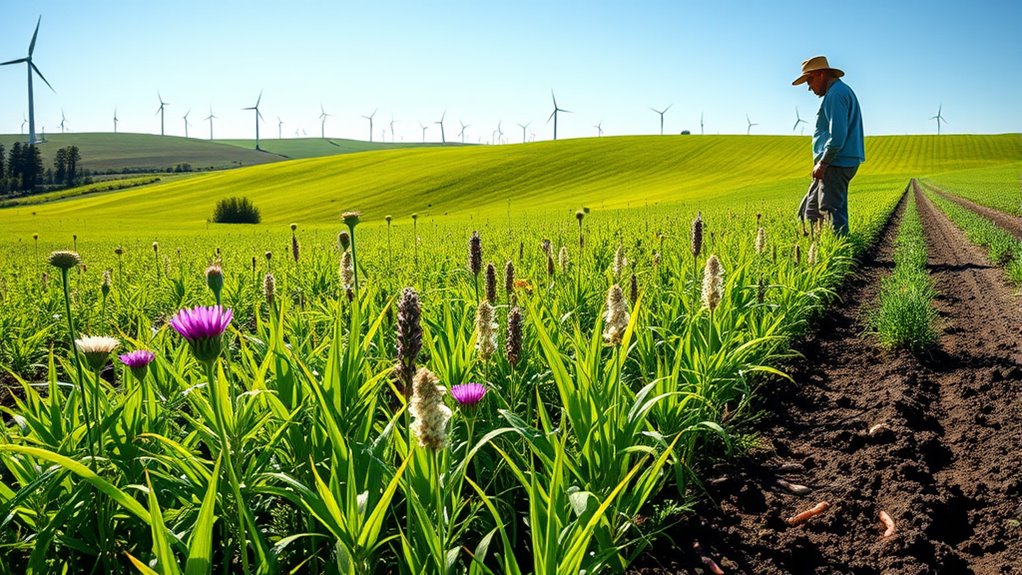Regenerative agriculture uses farming practices that build healthy soils, which in turn support the sustainable production of fashion fibers like hemp, organic cotton, and linen. Techniques such as cover cropping, reduced tillage, and composting improve soil organic matter, microbial activity, and moisture retention. These practices also sequester carbon, helping combat climate change. As you explore further, you’ll see how these methods create resilient land that benefits both the environment and fiber quality.
Key Takeaways
- Implement cover cropping to protect soil, improve water retention, and provide sustainable fiber sources like hemp and linen.
- Reduce tillage to maintain soil structure, enhance microbial activity, and increase soil carbon for fiber crop resilience.
- Use composting to enrich soil fertility, boost microbial diversity, and support healthy fiber plant growth.
- Promote crop diversity and rotation to enhance soil health, reduce pests, and sustain fiber crop yields.
- Adopt integrated soil management practices that sequester carbon, improve drought resistance, and support eco-friendly fashion fibers.

Have you ever wondered how farming can restore the health of the land rather than deplete it? In regenerative agriculture, the focus shifts from simply growing crops to nurturing the soil itself. Healthy soil is the foundation for vibrant ecosystems, resilient crops, and sustainable farming practices. When you adopt regenerative methods, you actively improve soil health by increasing organic matter, enhancing microbial activity, and reducing soil erosion. These practices don’t just benefit the land—they also play an essential role in climate change mitigation through carbon sequestration. As plants grow, they absorb carbon dioxide from the atmosphere and store it in the soil, effectively removing greenhouse gases and helping to stabilize the climate. This process is a natural part of regenerative farming, where practices like cover cropping, reduced tillage, and composting build soil carbon levels over time.
Regenerative farming heals the land by enhancing soil health and capturing carbon to fight climate change.
By prioritizing soil health, you create an environment where plants can thrive without relying heavily on synthetic fertilizers or chemical pesticides. Cover crops, for example, shield the soil from erosion, improve water retention, and feed beneficial microorganisms. These microorganisms, in turn, break down organic matter, releasing nutrients that support healthy plant growth. Reduced tillage prevents soil disturbance, maintaining the structure that holds carbon and moisture in place. Composting adds rich organic material back into the soil, boosting its fertility and microbial diversity. All these strategies work together to foster a resilient, self-sustaining system that continuously improves over time. Additionally, understanding and complying with regulations ensures that regenerative practices are sustainable and legally sound.
As you implement regenerative practices, you also contribute to the broader goal of climate resilience. Soil with high organic matter content can store more carbon, making farms more drought-resistant and better equipped to handle extreme weather. This not only benefits the environment but also ensures steady fiber production for fashion fibers, which often depend on crops like hemp, linen, or organic cotton. When the soil is rich and healthy, these crops grow more robustly, require fewer inputs, and are less vulnerable to pests and diseases.
Ultimately, regenerative agriculture empowers you to be part of a movement that heals the land while supporting sustainable fashion. You’re fostering a system where soil health and carbon sequestration go hand in hand, creating a positive cycle of growth and renewal. It’s about working with nature, not against it—building fertile, resilient land that sustains both the environment and your livelihood.
Frequently Asked Questions
How Does Regenerative Farming Impact Fiber Crop Yields?
Regenerative farming boosts fiber crop yields by improving soil health, which provides plants with better nutrients and water retention. As you adopt these practices, you’ll notice stronger crop resilience against pests, droughts, and diseases. This resilience means more consistent yields and healthier fibers. By maintaining soil robustness, you’re creating a sustainable cycle that supports higher productivity and quality in fiber crops, ensuring your farm remains productive and environmentally friendly over time.
Are There Any Certifications for Regenerative Fiber-Producing Farms?
Yes, there are certification standards and eco label programs for regenerative fiber-producing farms. These certifications verify that farms follow sustainable practices, improve soil health, and promote biodiversity. By earning eco labels like the Global Organic Textile Standard (GOTS) or Regenerative Organic Certified (ROC), you can confidently source fibers that support regenerative farming. These standards help you guarantee your supply chain aligns with environmentally responsible practices, making your fashion products more sustainable.
What Are the Costs Associated With Transitioning to Regenerative Practices?
Think of switching costs as planting seeds for a sustainable future. You’ll face initial expenses like soil amendments, equipment updates, and training, but a thorough cost analysis reveals potential savings over time. Financial incentives, grants, and certifications can offset these costs, making the shift more feasible. While upfront investments are significant, the long-term benefits—healthier land, better fiber quality, and environmental impact—far outweigh the initial financial hurdles.
How Do Regenerative Methods Influence Fiber Quality and Durability?
You’ll notice that regenerative methods improve fiber quality by enhancing soil health, which provides plants with better nutrients and stronger root systems. This results in fibers that are more resilient and durable, able to withstand wear and environmental stress. As soil health improves through practices like cover cropping and composting, the fibers become more robust, giving your garments longer life and better performance.
Can Regenerative Agriculture Practices Be Scaled for Large Fiber Farms?
Sure, scaling regenerative agriculture for large fiber farms is a breeze—just ignore the complexity! You can absolutely expand practices like nurturing the soil microbiome and promoting crop diversity, right? In reality, it’s challenging but doable. With innovation and commitment, you can adapt these methods to bigger farms, improving sustainability. Just remember, it’s a balancing act that requires patience and strategic planning to truly thrive at scale.
Conclusion
By embracing regenerative agriculture, you help restore soil health and promote sustainable fiber production. Imagine a small farm where switching to cover crops boosts soil fertility, leading to stronger cotton plants for your favorite jeans. This cycle of renewal not only benefits the environment but also guarantees you have access to high-quality, eco-friendly fibers. When you choose regenerative practices, you’re supporting a healthier planet and a more sustainable fashion future.









